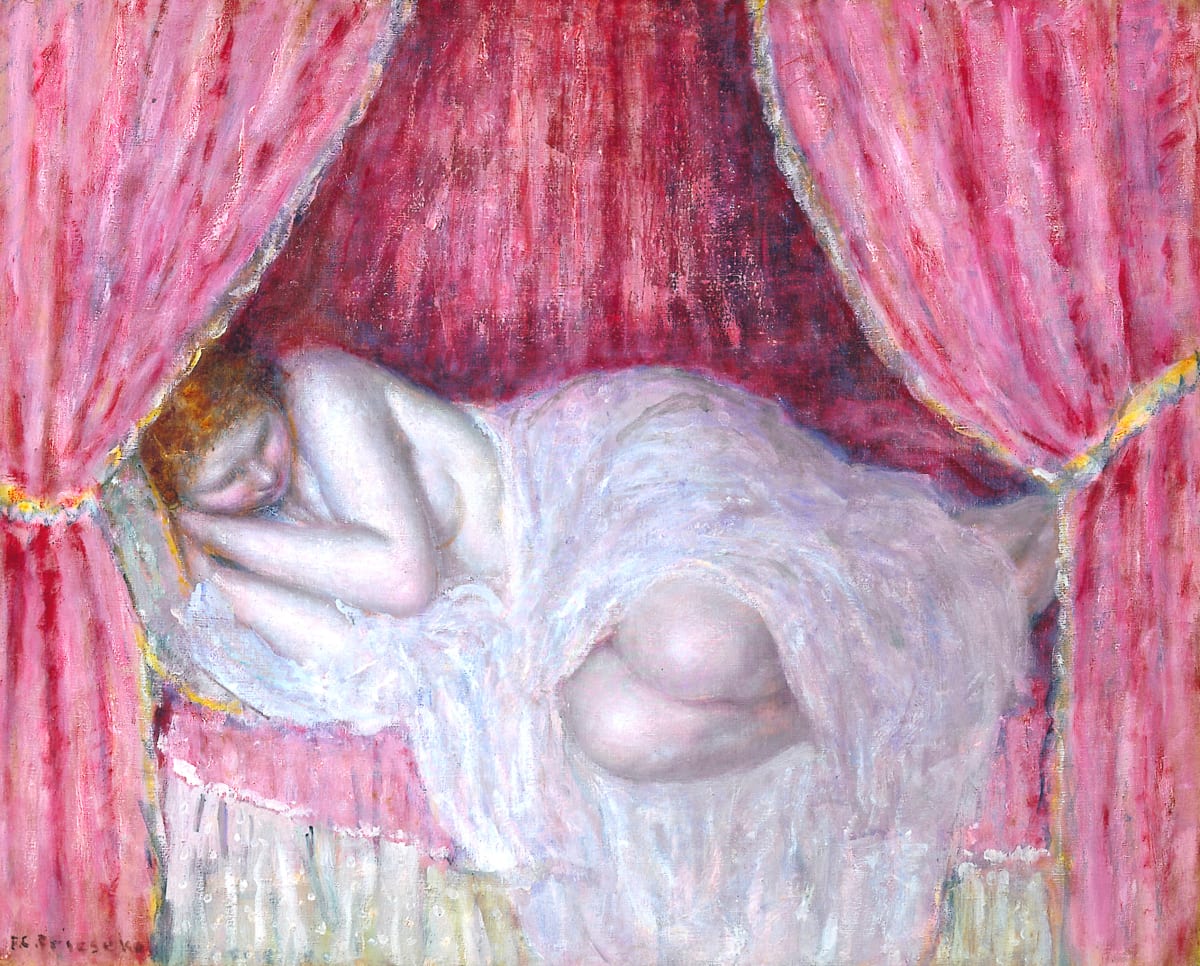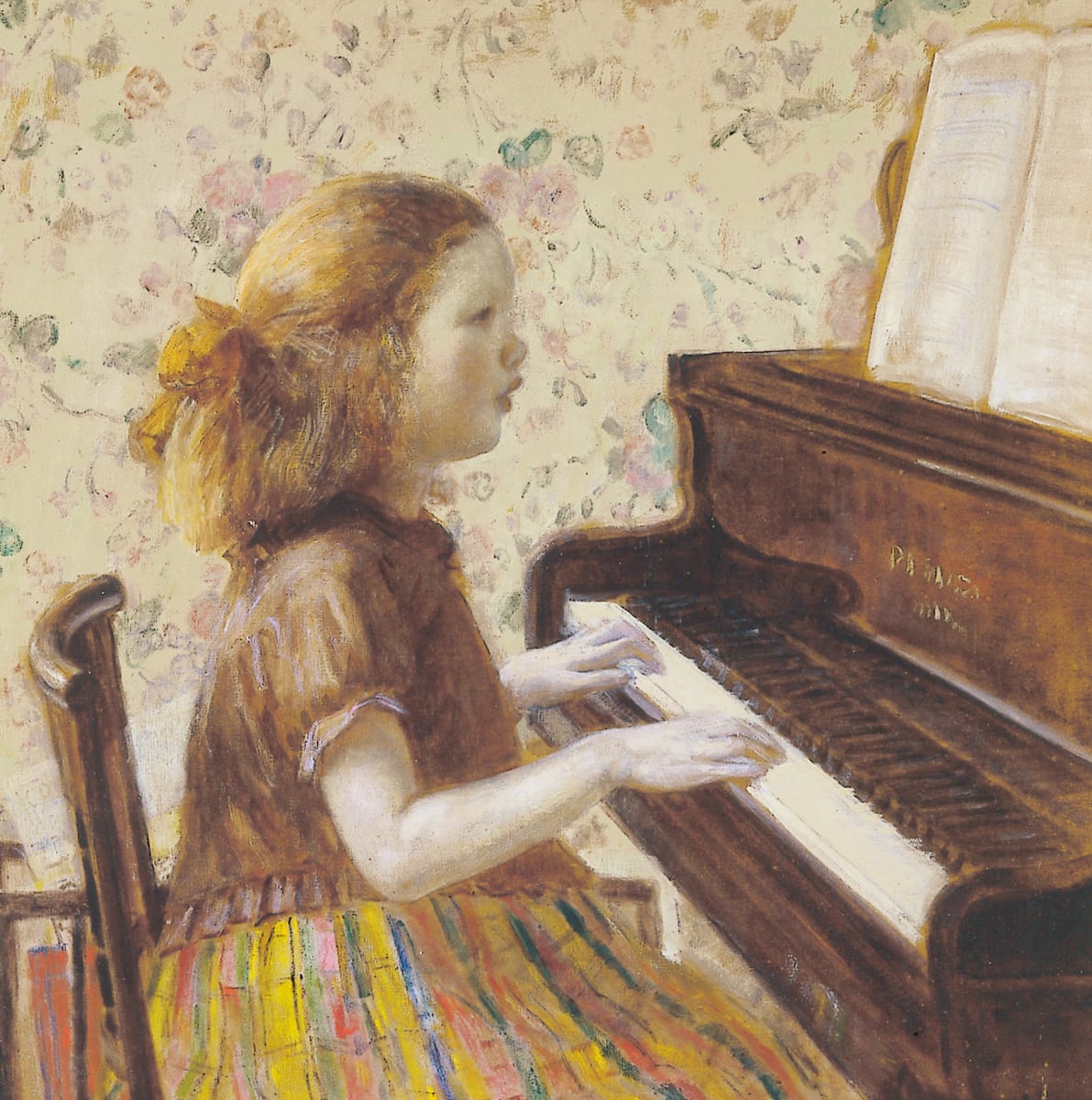
The majority of these ninety works have never been exhibited and come directly from the family of the artist.
Hollis Taggart Galleries will be presenting the exhibition: Chamber Works by Frederick C. Frieseke to open on Tuesday, November 28th. The concept for the exhibition, evolved naturally from the group of works that Hollis Taggart Galleries acquired from the artist’s estate. The collection of more than ninety paintings, watercolors, and etchings seemed to fall quite cohesively under this title. "Chamber" in this case holds a two-fold meaning. It infers intimacy, as found in a domestic scene unfolding in a room or boudoir. It also implies a modest scale, as in chamber music, which is composed for a few instruments to be played for a limited audience. Our exhibition is representative of these two aspects in Frieseke’s work–either they are small in scale, or bring the viewer into the cloistered interiors of sitting rooms and private dressing rooms of Frieseke’s world. The majority of these ninety works have never been exhibited and come directly from the family of the artist. Many, in fact, were part of Frieseke’s personal collection.
Hollis Taggart Galleries will be presenting the exhibition: Chamber Works by Frederick C. Frieseke to open on Tuesday, November 28th. The concept for the exhibition, evolved naturally from the group of works that Hollis Taggart Galleries acquired from the artist’s estate. The collection of more than ninety paintings, watercolors, and etchings seemed to fall quite cohesively under this title. "Chamber" in this case holds a two-fold meaning. It infers intimacy, as found in a domestic scene unfolding in a room or boudoir. It also implies a modest scale, as in chamber music, which is composed for a few instruments to be played for a limited audience. Our exhibition is representative of these two aspects in Frieseke’s work–either they are small in scale, or bring the viewer into the cloistered interiors of sitting rooms and private dressing rooms of Frieseke’s world. The majority of these ninety works have never been exhibited and come directly from the family of the artist. Many, in fact, were part of Frieseke’s personal collection.
Themes of family life and domesticity emerge as prevalent subjects throughout the artist’s body of work. Paintings of his wife Sarah and his daughter Frances figure prominently. Frieseke is often at his artistic peak when he is portraying these intimate subjects. The beautifully rendered Portrait of Frances, Child at Piano (Petite Fille Au Piano), and Le Dejeuner au Lit are works that reveal familial scenes from Frieseke’s life.
Frederick Carl Frieseke is known to a large audience primarily as an expatriate who joined the colony of fellow American painters residing in Giverny, France, in close proximity to Claude Monet. Many of the works in this exhibition were, in fact, executed during this period of 1905-19. The exhibition and accompanying catalogue reveal unusual aspects of the artist’s body of work. From the early pen and ink drawings of the late 1890s, to the atmospheric watercolors of Dutch landscapes, to the charcoals and etchings from the late 1920s and 1930s, a fascinating scope of Frieseke’s work is explored.
While Frieseke’s indebtedness to the Impressionists is often noted, Chamber Works also clearly demonstrates the artist’s affinity to the French group of painters known as the Nabis, with his use of patterns, flat pure color, and depictions of intimate settings. These techniques utilized by the Nabis group are revealed in the decorative patterning, rich upholstery, and lyricals surfaces in Frieseke’s works such as Nude in her Boudoir (Study for the Mansard Room), Blue Dress, Giverny, and The Chinese Robe.
Chamber Works will be shown concurrently at the gallery with Uneventful Reminiscences: A Childhood in Florida, 1881-85, a selection of works recalling Frieseke’s boyhood experience in Jacksonville, Florida. These eighteen watercolors are accompanied by a lively, autobiographical recollection of the artist’s days at the age nine in the tropical location. Pulling in Shark and The Saint John’s River, along with the other works in this series, were executed in 1921, years after Frieseke’s actual experience in Florida. After hearing a lecture describing a method of landscape painting done completely from memory, Frieseke revisited his past through these watercolors and memoir, Uneventful Reminiscences. This is the first time that both are offered for public view.
An abbreviated form of this exhibition will be hosted by the Shiawassee Arts Center in Owosso, Michigan, Frieseke’s birthplace. Chamber Works also anticipates a major traveling exhibition of the artist’s work that is being organized by the Telfair Museum of Art in Savannah, Georgia due to open in March of 2001. Furthermore, the exhibition officially launches Hollis Taggart Galleries’ sponsorship of the Frederick Carl Frieseke catalogue raisonné currently being compiled by Nicholas Kilmer.











